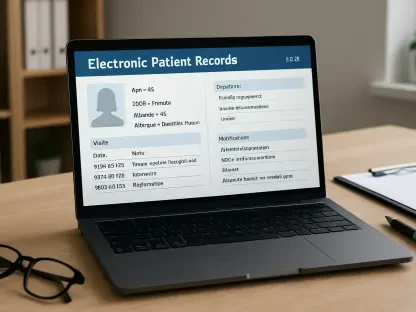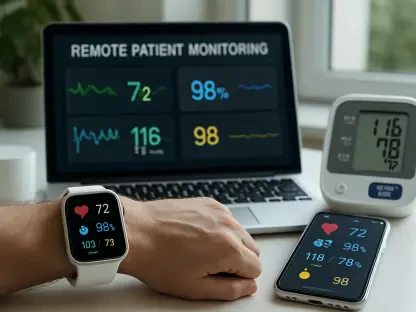Imagine a healthcare system where patient records flow seamlessly between providers, empowering individuals to manage their health with ease through digital tools, a vision recently put forth by the Trump administration to revolutionize interoperability in the U.S. healthcare landscape through a bold data-sharing initiative. With the Department of Health and Human Services (HHS) and Centers for Medicare & Medicaid Services (CMS) at the helm, alongside over 60 major companies like Amazon and Epic, the plan promises transformative change. Yet, beneath the ambitious rhetoric lies a critical gap: a lack of concrete implementation details. This roundup gathers diverse perspectives from industry leaders, technology experts, and privacy advocates to explore the potential, pitfalls, and unanswered questions surrounding this high-stakes initiative.
Breaking Down the Vision: What Experts Are Saying
Bold Ambitions Meet Vague Roadmaps
The core of this initiative is a voluntary CMS Interoperability Framework designed to enhance data exchange and expand digital tools for chronic disease management. Industry analysts commend the goal of breaking down long-standing data silos that have plagued healthcare for decades. However, many express concern over the absence of a detailed operational strategy. A common critique is that with over 60 companies involved, voluntary participation may lead to inconsistent efforts without clear guidelines on coordination or accountability.
Another point of discussion is the aggressive timeline set for initial outcomes within the first quarter of the next year. Some stakeholders view this as a motivator for rapid progress, arguing that urgency could spur innovation. Others, however, caution that such a short window risks superficial results, especially given the complexity of aligning diverse systems and stakeholders. The consensus leans toward skepticism about achieving meaningful impact without a more structured approach.
Privacy Concerns in a Data-Heavy Landscape
As the plan pushes for patient access to health data via third-party apps, privacy advocates raise red flags about security risks. Many of these apps may operate outside HIPAA regulations, creating vulnerabilities for sensitive information. Experts highlight that patients often lack awareness of how their data is used or shared, with surveys indicating a significant knowledge gap in understanding data access scopes. This burden of comprehension could undermine trust in the system.
On the flip side, proponents argue that broader data access is essential for patient empowerment and better care coordination. They suggest that the benefits of accessibility could outweigh the risks if proper safeguards are implemented. A key area of debate is the fragmented nature of state privacy laws, which complicates compliance for companies operating nationwide. Many agree that federal legislation may be necessary to provide a cohesive framework for protecting patient information.
Tech Challenges Across the Provider Spectrum
The adoption of the Fast Healthcare Interoperability Resources (FHIR) standard is a cornerstone of the initiative, aimed at standardizing data exchange. Technology experts note that while FHIR holds promise, its implementation varies widely across systems, with version mismatches creating interoperability hurdles. Large health systems with robust IT infrastructure are better positioned to adapt, but the same cannot be said for smaller entities.
Rural and under-resourced providers face significant barriers, often lacking the technical staff or financial means to integrate new standards. This disparity raises concerns about widening inequities in healthcare delivery. Some industry voices advocate for targeted support, such as grants or training programs, to level the playing field. Without such measures, there’s a risk that the initiative could inadvertently favor well-funded organizations, leaving critical segments of the system behind.
Systemic Issues Beyond Technology
Beyond technical challenges, the initiative’s focus on patient empowerment prompts questions about readiness. Health data, such as lab results or treatment histories, can be complex for laypersons to interpret without guidance. Analysts stress the need for educational tools and support mechanisms to bridge this gap, arguing that access alone isn’t enough to drive informed decision-making.
Regulatory gaps also loom large in discussions. The lack of comprehensive federal privacy laws leaves room for uncertainty, with some experts predicting that states may step in with their own regulations if misuse of data becomes a public issue. There’s a shared view that CMS must play a more active role in providing resources and structure, rather than relying solely on industry collaboration to push the initiative forward. This systemic perspective underscores the multifaceted nature of the challenge at hand.
Key Takeaways from Diverse Voices
Synthesizing the insights from various corners of the healthcare and technology sectors reveals a shared recognition of the initiative’s importance. Interoperability remains a critical need, and the involvement of major players alongside CMS signals a potential turning point. Yet, the lack of actionable steps to achieve the plan’s goals is a recurring theme, with many urging clearer timelines, defined roles, and measurable benchmarks to ensure progress.
Differing opinions on privacy and technology adoption highlight the complexity of balancing innovation with safeguards. While some see data access as a gateway to better care, others warn of security risks and inequities that could emerge if smaller providers are sidelined. A balanced approach, incorporating funding for rural facilities and standardized privacy guidelines, emerges as a frequent recommendation to address these disparities and build trust in the system.
Reflecting on the Path Traveled
Looking back, the discussions around this health data-sharing plan revealed a landscape of cautious optimism tempered by practical concerns. Experts across fields weighed in with valuable perspectives, shedding light on both the transformative potential and the significant hurdles that defined the initiative’s early stages. Their insights painted a picture of an ambitious effort grappling with the realities of a fragmented healthcare system.
Moving forward, actionable steps became a focal point for consideration. Prioritizing targeted support for under-resourced providers, establishing robust privacy protections, and ensuring regular updates from key stakeholders emerged as vital next steps. Additionally, fostering collaboration between CMS and industry leaders to create educational resources for patients stood out as a way to enhance the plan’s impact. These measures, if pursued, could help transform the vision into a tangible reality, paving the way for a more connected and equitable healthcare future.









